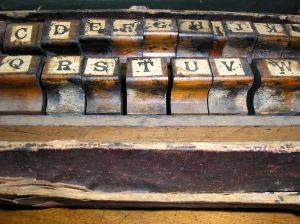Yesterday, Mike and I met with the lovely Jane Pightling at the Stephen Beaumont Museum of Mental Health in Wakefield. Secreted within the grounds of Fieldhead Hospital, walking into the museum is a little like walking into an Aladdin’s cave: it’s full of fascinating items that tell the story of the West Riding Pauper Lunatic Asylum (later, Stanley Royd Hospital), from its beginnings in 1818 to its closure in the 1990s.
Walking into the museum, we were met with an imposing marble-topped mortuary table – an item that invites the visitor to consider both the long-term nature of many patients’ stays within the asylum, but also the importance of post-mortem and brain research in casting light upon the pathology of mental disease.
Just a few steps away is a padded cell; elsewhere are iron manacles and a straitjacket. These stock items of asylum history are, however, set alongside other objects that tell a much deeper story about the care of the asylum patient: a hydrotherapy bath, printing blocks, hand tools, and patient art.
In a corner stands a beautiful wooden lectern in the shape of an eagle, and on the opposite wall is a cleverly fashioned mirror frame – both made by patients. On one wall are photographs and programmes from theatrical productions put on by patients and staff, and sheet music and scripts testament to a staging of Gilbert and Sullivan’s ‘Trial by Jury’.
The museum contains many stories and voices – of patients, attendant and nursing staff, doctors, and local people. Its location within the hospital grounds is, we discovered, ideal: Jane explained to us how school groups might arrive in the museum to learn about the history of electro-convulsive therapy, before going to look at the hospital’s modern ECT suite.
Under the umbrella of South West Yorkshire Partnership’s Change Lab project, the museum staff are currently looking at how to get even more out of their collections in order to raise awareness of the history of mental illness, and the experience of those with mental health problems.
Delegates at the Science in the Asylum conference on 19 October are warmly invited to visit the museum after the conference for a look at the exhibits, as well as some light refreshment, where Jane and her colleagues will be on hand to talk about the collections and future plans.
For those not attending the conference, the museum is free to visit and currently opens each Wednesday between 10am and 3.30pm. Visits outside these hours can also be arranged by contacting Jane or another member of the museum team on 01924 328654.
– Jennifer Wallis






I agree with you about like been like an aladdins cave, I knew it when It was in the grounds of Stanley Royd when I worked there for a lot of years, it was a wonderful place to work, a happy place. I am glad you both enjoyed the visit.
Pingback: Communicating Mental Health, University of Birmingham, 16-17 September 2013 | Asylum Science
Requesting ideas on how to start a mental health museum in Palm Beach County? I am 46 years old and have been both burdened and blessed with bipolar. After completing my Masters in Social Work from Florida Atlantic University I immediately opened up an agency and dedicated myself, along with my staff to helping those in need of mental wellness. After years of effort and minimal support for change, I realize that the true start to recovery must start with experiential education designed to break the walls of stigma.
Hi Minerva,
I’m certainly no expert on museums particularly, but there are a few examples of small projects that might prove useful examples/starting points:
London Asylum Restoring Perspectives exhibit: https://www.lib.uwo.ca/archives/virtualexhibits/londonasylum/about.html
Missouri State Archives exhibit re: their first state hospital: http://www.sos.mo.gov/archives/exhibits/Quest/
Hydrotherapy exhibit: http://www.cornellpsychiatry.org/history/osk_die_lib/hydrotherapy/default.htm
Willard Suitcase exhibit: http://www.suitcaseexhibit.org/index.php?section=about&subsection=suitcases
Part website, part archive, part exhibit: http://historyofmadness.ca/
More website than exhibit but covers history of psychiatry in France: http://psychiatrie.histoire.free.fr/
Check out also the Oregon State Hospital Museum blog: http://oshmuseum.org/ – they discuss their museum in a quite a bit of detail with great pictures.
You might also want to get in touch with Jennifer Bazar at the Remembering Oak Ridge project (to whom I’m indebted for the above info!): https://historyexhibit.waypointcentre.ca/
An interesting book that covers some of the challenges of addressing mental health in museum is Coleborne and Mackinnon’s Exhibiting Madness in Museums (2011).
Good luck!